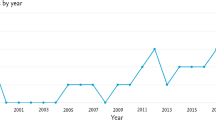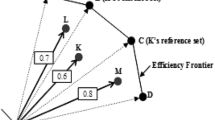Abstract
This paper presents a new data envelopment analysis (DEA) target setting approach that uses the compromise programming (CP) method of multiobjective optimization. This method computes the ideal point associated to each decision making unit (DMU) and determines an ambitious, efficient target that is as close as possible (using an lp metric) to that ideal point. The specific cases p = 1, p = 2 and p = ∞ are separately discussed and analyzed. In particular, for p = 1 and p = ∞, a lexicographic optimization approach is proposed in order to guarantee uniqueness of the obtained target. The original CP method is translation invariant and has been adapted so that the proposed CP-DEA is also units invariant. An lp metric-based efficiency score is also defined for each DMU. The proposed CP-DEA approach can also be utilized in the presence of preference information, non-discretionary or integer variables and undesirable outputs. The proposed approach has been extensively compared with other DEA approaches on a dataset from the literature.




Similar content being viewed by others
References
Aparicio, J. (2016). A survey on measuring efficiency through the determination of the least distance in data envelopment analysis. Journal of Centrum Cathedra,9(2), 143–167.
Aparicio, J., Cordero, J. M., & Pastor, J. T. (2017). The determination of the least distance to the strongly efficient frontier in data envelopment analysis oriented models: Modelling and computational aspects. Omega,71, 1–10.
Aparicio, J., Ruíz, J. L., & Sirvent, I. (2007). Closest targets and minimum distance to the Pareto-efficient frontier in DEA. Journal of Productivity Analysis,28, 209–218.
Asmild, M., & Pastor, J. T. (2010). Slack free MEA and RDM with comprehensive efficiency measures. Omega,38, 475–483.
Banker, R. D., Charnes, A., & Cooper, W. W. (1984). Some models for estimating technical and scale inefficiencies in data envelopment analysis. Management Science,30(9), 1078–1092.
Banker, R. D., & Morey, R. (1986). Efficiency analysis for exogenously fixed inputs and outputs. Operations Research,34, 513–521.
Carrillo, M., & Jorge, J. M. (2016). A multiobjective DEA approach to ranking alternatives. Expert Systems with Applications,50, 130–139.
Chen, Y. W., Larbani, M., & Chang, Y. P. (2009). Multiobjective data envelopment analysis. Journal of the Operational Research Society,60, 1556–1566.
Chiang, C. I., Hwang, M. J., & Liu, Y. H. (2011). Determining a common set of weights in a DEA problem using a separation vector. Mathematical and Computer Modelling, 54, 2464–2470.
Cook, W. D., & Zhu, J. (2007). Within-group common weights in DEA: An analysis of power plant efficiency. European Journal of Operational Research,178, 207–216.
Cooper, W. W., Park, K. S., & Pastor, J. T. (1999). RAM: A range adjusted measure of inefficiency for use with additive models, and relations to other models and measures in DEA. Journal of Productivity Analysis,11(1), 5–42.
Cooper, W. W., Seiford, L. M., & Tone, K. (2006). Data envelopment analysis: a comprehensive text with models, applications, references and DEA-solver software (2nd ed.). New York: Springer.
Cooper, W. W., Seiford, L. M., & Zhu, J. (2004). Handbook on data envelopment analysis. New York: Springer.
Davoodi, A., & Rezai, H. Z. (2012). Common set of weights in data envelopment analysis: A linear programming problem. Central European Journal of Operational Research,20, 355–365.
Dehnokhalaji, A., & Soltani, N. (2019). Gradual efficiency improvement through a sequence of targets. Journal of the Operational Research Society,70(12), 2143–2152.
Despotis, D. K. (2002). Improving the discriminating power of DEA: Focus on globally efficient units. Journal of the Operational Research Society,53, 314–323.
Despotis, D. K., Sotiros, D., & Koronakos, G. (2016). A network DEA approach for series multi-stage processes. Omega,61, 35–48.
Ebrahimnejad, A., & Tavana, M. (2014). An interactive MOLP method for identifying target units in output-oriented DEA models: The NATO enlargement problem. Measurement,52, 124–134.
Färe, R., Grosskopf, S., & Wittaker, G. (2013). Directional output distance functions: Endogenous constraints based on exogenous normalization constraints. Journal of Productivity Analysis,40, 267–269.
Freimer, M., & Yu, P. L. (1976). Some new results on compromise solutions for group decision problems. Management Science,22(6), 688–693.
Fukuyama, H., & Weber, W. L. (2009). A directional slacks-based measure of technical inefficiency. Socio-Economic Planning Sciences,43(4), 274–287.
Gutiérrez, E., & Lozano, S. (2016). Efficiency assessment and output maximization possibilities of European small and medium sized airports. Research in Transportation Economics,56, 3–14.
Hampf, B., & Krüger, J. J. (2015). Optimal directions for directional distance functions: An exploration of potential reductions of greenhouse gases. American Journal of Agricultural Economics,97(3), 920–938.
Hashimoto, A., & Wu, D. A. (2004). A DEA-compromise programming model for comprehensive ranking. Journal of the Operations Research Society of Japan,47(2), 73–81.
Hosseinzadeh Lotfi, F., Hatami-Marbini, A., Agrell, P. J., Aghayi, N., & Gholami, K. (2013). Allocating fixed resources and setting targets using a common-weights DEA approach. Computers and Industrial Engineering, 64, 631–640.
Hosseinzadeh Lotfi, F., Jahanshaloo, G. R., & Memariani, A. (2000). A method for finding common set of weights by multiple objective programming in data envelopment analysis. Southwest Journal of Pure and Applied Mathematics,1, 44–54.
Jahanshaloo, G. R., Memariani, A., Hosseinzadeh Lotfi, F., & Rezai, H. Z. (2005). A note on some of DEA models and finding efficiency and complete ranking using common set of weights. Applied Mathematics and Computation, 166(2), 265–281.
Kao, C. (2010). Weight determination for consistently ranking alternatives in multiple criteria decision analysis. Applied Mathematical Modelling,34, 1779–1787.
Kao, C., & Hung, H. T. (2005). Data envelopment analysis with common weights: The compromise solution approach. Journal of the Operational Research Society,56, 1196–1203.
Korhonen, P. J., Dehnokhalaji, A., & Nasrabadi, N. (2018). A lexicographic radial projection onto the efficient frontier in data envelopment analysis. European Journal of Operational Research,265, 1005–1012.
Kuosmanen, T. (2005). Weak disposability in nonparametric production analysis with undesirable outputs. American Journal of Agricultural Economics,87(4), 1077–1082.
Lee, C. Y. (2018). Mixed-strategy Nash equilibrium in data envelopment analysis. European Journal of Operational Research,266, 1013–1024.
Lozano, S., & Calzada-Infante, L. (2018). Computing gradient-based stepwise benchmarking paths. Omega,81, 195–207.
Lozano, S., & Villa, G. (2005). Determining a sequence of targets in DEA. Journal of the Operational Research Society,56, 1439–1447.
Lozano, S., & Villa, G. (2006). Data envelopment analysis of integer-valued inputs and outputs. Computer and Operations Research,33(10), 3004–3014.
Lozano, S., & Villa, G. (2010). Gradual technical and scale efficiency improvement in DEA. Annals of Operations Research,173, 123–136.
Marler, R. T., & Arora, J. S. (2004). Survey of multi-objective optimization methods for engineering. Structural and Multidisciplinary Optimization,26(6), 369–395.
Nasrabadi, N., Dehnokhalaji, A., Korhonen, P., & Wallenius, J. (2019). A stepwise benchmarking approach to DEA with interval scale data. Journal of the Operational Research Society,70(6), 954–961.
Omrani, H. (2013). Common weights data envelopment analysis with uncertain data: A robust optimization approach. Computers and Industrial Engineering, 66, 1163–1170.
Pastor, J. T., Aparicio, J., Alcaraz, J., Vidal, F., & Pastor, D. (2016). The reverse directional distance function. In J. Aparicio, et al. (Eds.), Advances in efficiency and productivity (pp. 15–55). Berlin: Springer.
Roll, Y., & Golany, B. (1993). Alternate methods weights of treating factor in DEA. Omega,21(1), 99–109.
Soltani, N., & Lozano, S. (2018). Potential-based efficiency assessment and target setting. Computers & Industrial Engineering,126, 611–624.
Sun, J., Wu, J., & Guo, D. (2013). Performance ranking of units considering ideal and anti-ideal DMU with common weights. Applied Mathematical Modelling,37, 6301–6310.
Tavana, M., Ebrahimnejad, A., Santos-Arteaga, F. J., Mansourzadeh, S. M., & Matin, R. K. (2018). A hybrid DEA-MOLP model for public school assessment and closure decision in the City of Philadelphia. Socio-Economic Planning Sciences,61, 70–89.
Thomson, W. (1994). Cooperative models of bargaining. In R. J. Aumann & S. Hart (Eds.), Handbook of game theory (Vol. 2, pp. 1237–1284). Amsterdam: North-Holland.
Tone, K. (2001). A slacks-based measure of efficiency in data envelopment analysis. European Journal of Operational Research,130(3), 498–509.
Wang, Y. M., Chin, K. S., & Luo, Y. (2011a). Cross-efficiency evaluation based on ideal and anti-ideal decision making units. Expert Systems with Applications,38, 10312–10319.
Wang, Y. M., & Luo, Y. (2006). DEA efficiency assessment using ideal and anti-ideal decision making units. Applied Mathematics and Computation,173, 902–915.
Wang, Y. M., Luo, Y., & Lan, Y. X. (2011b). Common weights for fully ranking decision making units by regression analysis. Expert Systems with Applications,38, 9122–9128.
Wang, K., Xian, Y., Lee, C. Y., Wei, Y. M., & Huang, Z. (2019). On selecting directions for directional distance functions in a non-parametric framework: A review. Annals of Operations Research,278, 43–76.
Yu, P. L. (1973). A class of solutions for group decision problems. Management Science,19(8), 936–946.
Zohrehbandian, M., Makui, A., & Alinezhad, A. (2010). A compromise solution approach for finding common weights in DEA: An improvement to Kao and Hung’s approach. Journal of the Operational Research Society,61, 604–610.
Acknowledgements
This research was carried out with the financial support of the Spanish Ministry of Economy, Industry and Competitiveness and the European Regional Development Fund, Grant DPI2017-85343-P. Narges Soltani acknowledges the support of a grant from the Ministry of Science, Research and Technology of the Islamic Republic of Iran.
Author information
Authors and Affiliations
Corresponding author
Additional information
Publisher's Note
Springer Nature remains neutral with regard to jurisdictional claims in published maps and institutional affiliations.
Rights and permissions
About this article
Cite this article
Lozano, S., Soltani, N. & Dehnokhalaji, A. A compromise programming approach for target setting in DEA. Ann Oper Res 288, 363–390 (2020). https://doi.org/10.1007/s10479-019-03486-7
Published:
Issue Date:
DOI: https://doi.org/10.1007/s10479-019-03486-7




